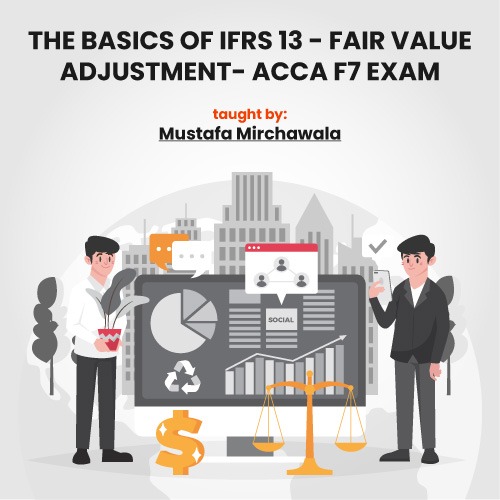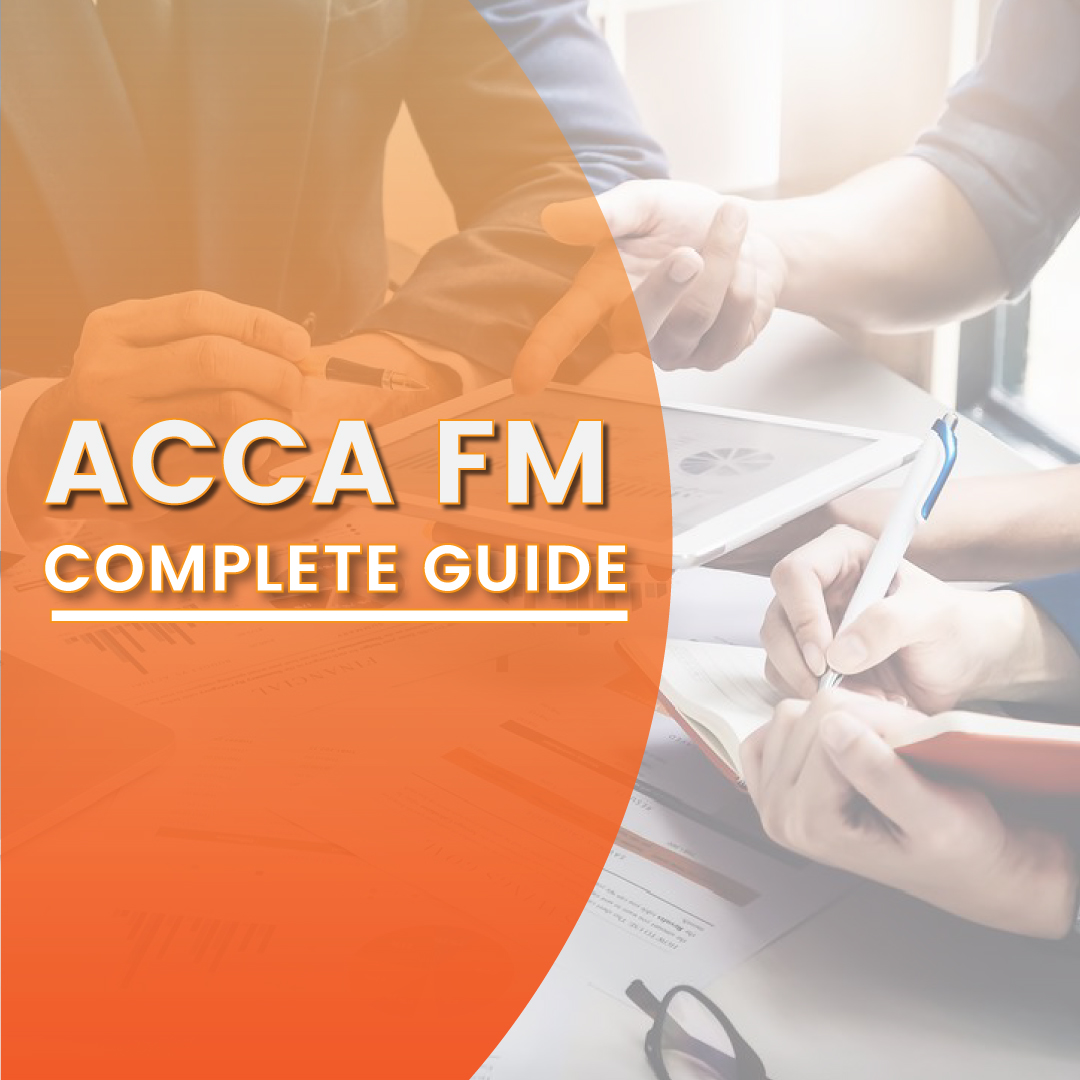“Maximizing ACCA F7 Success with IFRS 13-Fair Value Adjustment Strategies”

What establishes the Necessity of IFRS 13?
The International Financial Reporting Standards (IFRS) 13 ‘Fair Value Measurement’ describes how to measure fair value by giving explicit definitions and proposing a single set of requirements for practically all fair valuations. It explains how to estimate fair value when a market isn’t as active.
Because fair value adjustment was necessary for many standards and it applies to more than 20 standards, a new IFRS was established to summarise the extensive data of standards. It deals entirely with the purpose of fair value adjustment required for various criteria.
the second reason for the establishment of IFRS 13 was that because fair value is evaluated using a judgment basis and is usually a subjective affair, it exposes the potential for fraud and increases the risk of threatening organizational internal control. Therefore a new standard was launched to cater to the risk of fraud.
Standard on which IFRS 13 is not applied
However, there are a few exceptions where IFRS 13 is not applied:
1. IFRS 2 Share-based payments
2. IAS 2 Inventory
3. Measurements that are similar to but not categorized as fair value
IFRS 2 Share-based payments:
IFRS 13 does not apply to share-based payment transactions that fall under the purview of IFRS 21.IAS 21 prescribes how an entity should: account for foreign currency transactions; translate financial statements of a foreign operation into the entity’s functional currency; and translate the entity’s financial statements into a presentation currency, if different from the entity’s functional currency.
IAS 2 Inventory:
Specifically, the IAS 2 which deals with inventory valuation is out of the scope of IFRS 13. According to the **International Accounting Standard (IAS) 2, which deals with inventories, inventories are required to be measured at the lower of cost and net realizable value (NRV). The standard also outlines acceptable methods of determining cost, including specific identification, first-in first-out (FIFO), and weighted average cost.
On the other hand, IFRS 13 provides guidance on fair value measurement and applies to a wide range of financial and non-financial assets and liabilities It does not specifically address the measurement of inventories. Therefore, IFRS 13 is not applied to inventory valuation as it is covered by IAS 2.
Please note that this is a general explanation. For more detailed information, you may refer to the official documentation of IAS 2 and IFRS 13
3. Measurements that are similar to but not categorized as fair value:
Certain measurements that are similar to but not classed as fair value are excluded from the scope of IFRS 13. Net realizable value in IAS 2 Inventories and value in use in IAS 36 Impairment of Assets are two examples.
Promotes entity-based while discourages market-based
Fair value is a market-based evaluation, not an entity-specific measurement, according to the International Financial Reporting Standard (IFRS) 13. It defines fair value as “the price that would be received to sell an asset or paid to transfer a liability in an orderly transaction between market participants at the measurement date” The goal of a fair value measurement is to estimate the price at which an orderly transaction between market participants to sell the asset or transfer the liability would take place at the measurement date under current market conditions.
In other words, fair value is determined based on the price that would be received if the asset or liability were sold in an orderly transaction between market participants, rather than being based on entity-specific factors.
Please note that there are three levels of inputs used in fair value measurements: Level 1 inputs are quoted prices in active markets for identical assets or liabilities; Level 2 inputs are observable market data other than quoted prices included in Level1
Level 3 inputs are unobservable inputs that are not supported by market activity
Examples from different sources
Example 01-charity organization:
There is a company that owns a charity organization, now the owner of the football club reached out to me to donate to his club but there was a condition set which stated that the club would only be used for football matches. now if the company decided to sell this football club to a third party then in such case the condition would become ineligible. meaning such conditions only apply to entities and not other market participants. This is an entity-based factor and this will be ignored in fair value Adjustment
Example 02-Pakistan to Iran road rights
The government is the Pakistan to Iran road rights and the condition is that whoever acquires such rights. Therefore this is a market factor and will be incorporated in fair value adjustment. here market-based factors will be promoted and entity-based factors will be discouraged. if you are confused about this let me give you a brief two-line summary, remember those two lies and then come to the conclusion of considering whether market-based or entity-based factors
Summary: If that restriction is on investors only then it is an entity-based factor but if that restriction is characteristic of an asset then it is a market-based factor.
Example 03 – Transaction cost
Transaction cost will always be considered an entity-based factor because the control of transaction cost is in the hands of the entity. Transaction costs are the expenses incurred when acquiring or disposing of an asset or liability. They include fees, commissions, and taxes paid to third parties. In the context of IFRS 13, transaction costs are not considered a characteristic of an asset or liability and do not affect the fair value measurement. The fair value measurement is focused on the assumptions made by market participants and does not take into account entity-specific factors such as transaction costs. The rationale behind this is to ensure that the fair value reflects the price that would be received to sell an asset or paid to transfer a liability in an orderly transaction between market participants at the measurement date. Therefore, transaction costs are not included in the calculation of fair value under IFRS 13
The new definition of fair value
It is recommended by sir Mustafa Mirchawala to his financial reporting students to memorize this definition from word to word since this is a highly examinable topic Definition: ‘’It is the exit price to sell an asset or price paid to transfer a liability in an orderly transaction between market participant at the measurement date.’’
Just the way assets have their fair value the same way liability also has its fair value
Now let us explain this definition by word to word:
Explanation for exit price to sell an asset or price paid to transfer a liability
The asset is a resource whereas loan and liability are the burden/responsibility of the entity. when a resource or asset is sold you will receive proceeds whereas when liability is transferred you will have to pay because you are transferring your own duty to the third party. That’s why the word “price paid to transfer” is used in case of liability.
Explanation for an orderly transaction
To calculate fairvalue you will have to determine the transactions happening in the market such transactions should be in order.
Examples for non orderly transaction
1. Not related party transaction
2. No forced sale
3. No urgent sale
4. Parties must have knowledge of goods
5. The unit of account must be appropriate
A further explanation of each of them is provided below
Not related party transaction: wherever there is interest interest-aligned transaction for example the father’s company selling the asset to his son, ‘s company. such transactions will not be considered for evaluating fair value
No forced sale/No urgent sale: transactions done under any pressure from the board or under pressure due to time are not considered to be orderly transactions.
Parties must have knowledge of goods: This is the most important point. if the person holding the transaction doesn’t have enough knowledge regarding that niche then how can such a transaction be used to acquire the fairvalue of an asset because the person will even buy 1000$ worth of assets for 1500$ due to lack of knowledge There is an example in ICAEW from 2014 past paper. Considering that there are three identical buildings in London and the middle one is owned by our company, now if I have to evaluate the fairvalue of my own building I will have to look at the transaction of the rest of the two buildings which have also been sold. Among these 2 buildings, one was bought by a foreign investor who lacked the knowledge and due to time pressure bought the building for a value which was way past the normal value, now this transaction will not be considered to evaluate the fairvalue of our company buildings fair value.
The unit of account must be appropriate: orderly transaction also means that the unit of account must be appropriate.
Explanation: In general, there is always one shareholder of the company who holds one or two percent of the shares therefore he/she doesn’t hold any control nor significant influence on the company in comparison to shareholders having more percentage holding with more control and significant influence. the party holding more than 70 percent of shares is considered to be a parent company. Now if the parent company directors told the junior accountant to evaluate the fairvalue of their shares ( having 70 percent control). the junior accountant calculated the fair value on the basis of shares trading in the stock market. remember that the shares trading in the stock market are those of two percent holding shares .therefore the junior accountant used the wrong unit to measure the fair value. The fair value of 70 percent of control shares is not evaluated on the basis of per share. do not use non-controlling interest on this basis.
The last part of the definition ( between market participants at the measurement date)
This part of the definition means that now you will have to go to market to determine fair value, the question here is which type of market? always go for the principle market first. The principal market is the market with the highest level of activity meaning that that asset is sold the most in that market. the priority is always principle market was fair value calculation.
Now the question is why principle market is priority? For example, there are mobile markets located in the north of the city and one market is located in the south. In the north market, there is high perfect competition( many buyers and many sellers) meaning a lot of mobile phones are being sold there, such markets are highly informative in comparison to the market located in the south, where there are not many buyers and sellers. therefore the market with a high amount of transactions is used to calculate fair value, the average would be more accurate
If we can’t access to principal market or if the markets are at the same level then go for the most advantageous market. Here are the Steps for the Most Advantageous Market, pick the market with the highest net benefit and then move on to calculating fair value. To check the net benefit subtract the transportation and transaction costs from the selling price to acquire the net benefit. among the two companies, the one with the highest net benefit will be selected for fair value calculation. Now in the calculation of fair value do not use transaction cost as it is an entity-based factor ( discussed earlier ) , only subtract transportation cost from the selling price.
The last part of the definition – measurement date
Fair value is always calculated at year-end, but not in all cases. Remember IFRS 5 when an asset was classified as held for sale in the mid-year then the measurement date for fair value is calculated at the mid-year
Market valuation techniques
The market valuation technique is a method used to determine the appraisal value of a business, intangible asset, business ownership interest, or security. It involves considering the market prices of comparable assets or businesses that have been sold recently or are still available The market approach is based on the selling price of similar assets and is used to determine the value of an asset.
Please note that there are many techniques used for doing a valuation, and an analyst placing a value on a company looks at various factors such as the business’s management, the composition of its capital structure, and the prospect of future earnings. In our course outline we have three valuation techniques
Market approach valuation technique
Among these three this valuation technique is the most common one.
Cost Approach valuation technique
This approach is also known as the replacement technique. For instance the asset, you are calculating fair value is not available in the market now if I replace my asset with a new asset then this is known as a replacement valuation technique
Income approach valuation technique
When there is no market approach for the asset then the fair value is calculated on the basis of the benefit acquired by that asset in the future
First, let us understand the difference between identical and similar. Identical means completely the same whereas similar is when there are some similarities between two things.
Hierarchy Level of inputs
We will use these levels for the calculation of fair value. there are three levels and the condition is to go from top to bottom IFRS 13 is a standard that provides guidance on fair value measurement. It establishes a **fair value hierarchy** that categorizes the inputs to valuation techniques into three levels.
Level 1: Quoted prices (unadjusted) in active markets for identical assets or liabilities.
Level 2: Inputs other than quoted prices included within Level 1 that are observable for the asset or liability, either directly or indirectly.
Level 3: Unobservable inputs for the asset or liability.
The fair value hierarchy is used for disclosure and comparability purposes, allowing users of financial statements to understand the reliability and significance of the inputs used in fair value measurements.
Level 1: Unadjusted quoted prices of identical goods in an active market E.g. Stock exchange. No, manual calculation is needed . for example, in the case of a stock exchange, the last price for which the exact same stock is traded will be considered as fair value of that particular stock. if level 1 is not applied then move on to level 2
Level 2: Adjusted quoted prices of identical goods in an inactive market. Adjusted quoted prices of similar goods in an active market. E.g. Real state. In the stock exchange market, there are some sideboard stocks that rarely show on the screen. They are not actively traded in the market. now you will have to adjust it manually according to the last price the share was traded for. if the level 2 criteria didn’t meet then move on to level 3
Level 3: If there is no way then calculate the present value of future cash flows from that asset. there was some kind of observation in the past 2 levels but here it is dependent on future cash flows. this is given the least priority and that’s why it is called observable input or management guess. disclosure requirement for level 3 is
For level 3 detailed disclosure requirements
– You must disclose assumptions you have taken for future cash flow.
– Even you need to give sensitivity analysis disclosures.
– If there is a change in level from one year to another, this needs to be disclosed.
– Different disclosure requirements for recurring &non-recurring fair value items. These are reported every year in the financial statements
Frequently Asked Questions (FAQ’s)
Q1. What establishes the necessity of IFRS 13?
IFRS 13 is necessary to provide explicit definitions and requirements for fair value measurement, especially when markets are not active. It also addresses the risk of fraud in fair value assessments.
Q2. Which standards are exempt from IFRS 13?
IFRS 2 Share-based payments, IAS 2 Inventory, and measurements similar to fair value are exceptions to IFRS 13.
Q3. How does IFRS 13 promote entity-based over market-based factors?
IFRS 13 emphasizes market-based factors in fair value measurement, ignoring entity-specific conditions.
Q4. What is the new definition of fair value according to IFRS 13?
Fair value is “the exit price to sell an asset or price paid to transfer a liability in an orderly transaction between market participants at the measurement date.”
Q5. What are some examples of non-orderly transactions affecting fair value?
Non-related party transactions, forced or urgent sales, lack of knowledge by involved parties, and inappropriate units of account can impact fair value.
Q6. Why is the principal market prioritized in fair value calculation?
The principal market is preferred due to its higher transaction volume, making it more informative for fair value assessment.
Q7. What should be considered when selecting the most advantageous market?
Choose the market with the highest net benefit, considering transportation and subtracting transaction costs, without considering entity-based factors like transaction costs.
Written by Warisha Shehzadi bright student of Mirchawala’s Hub OF Accountancy











[…] September 30, 2023 […]
[…] September 30, 2023 […]
[…] September 30, 2023 […]
[…] September 30, 2023 […]
[…] Asset-IAS 41 The simplest definition of a biological asset Read more September 30, […]
[…] Asset-IAS 41 The simplest definition of a biological asset Read more September 30, […]
[…] Asset-IAS 41 The simplest definition of a biological asset Read more September 30, […]
[…] Asset-IAS 41 The simplest definition of a biological asset Read more September 30, […]
[…] Asset-IAS 41 The simplest definition of a biological asset Read more September 30, […]
[…] Asset-IAS 41 The simplest definition of a biological asset Read more September 30, […]
Comments are closed.